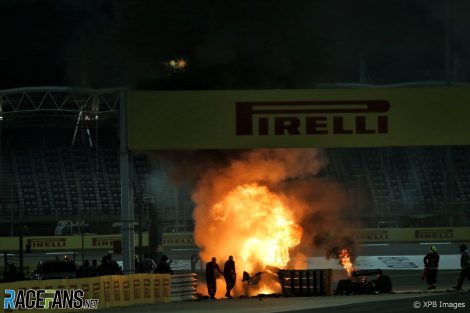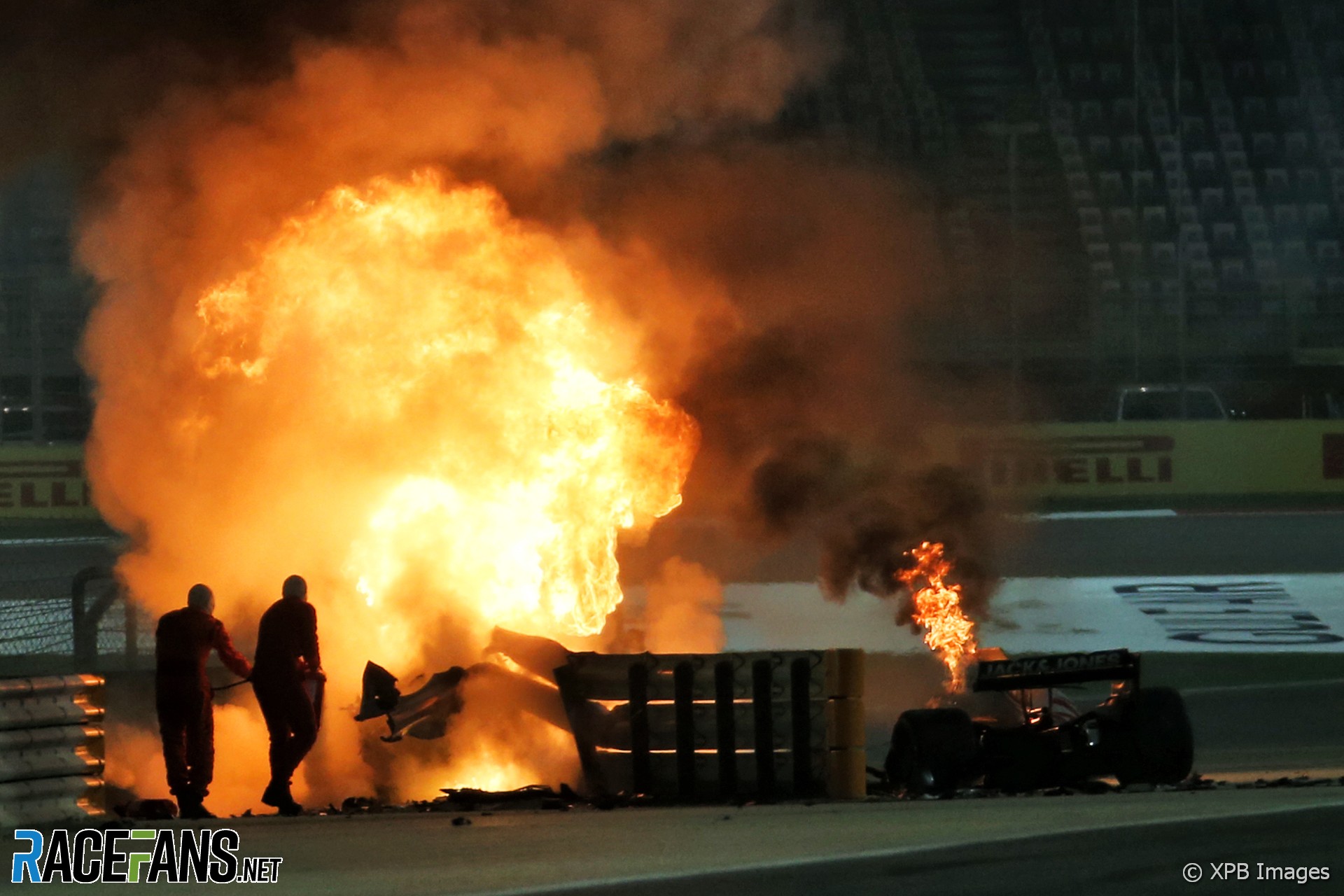The FIA has begun its investigation into Romain Grosjean’s fiery crash on the first lap of the Bahrain Grand Prix.
The sport’s governing body expects to publish details of its findings in “six to eight weeks”.The FIA’s safety director Adam Baker said the investigation will scrutinise all available data from what happened up to and after Grosjean’s 53G impact with the barrier.
“As with all serious accidents, we will analyse every aspect of this crash and collaborate with all parties involved,” said Baker. “With so much data available in Formula 1, it allows us to accurately determine every element of what occurred and this work has already begun.
“We take this research very seriously and will follow a rigorous process to find out exactly what happened before proposing potential improvements.”
The investigation will closely examine all safety devices which helped Grosjean survive the impact and fire which followed, including his helmet, HANS, safety belts and clothing. The car’s survival cell – which separated from the rear of the car in the impact – its headrest, onboard fire extinguisher system and Halo will also be studied.

The role played by the barrier in the crash will also form part of the investigation. Some drivers have raised concerns that Grosjean’s car was able to split the girders in the barrier and become lodged within it when it crashed.
The analysis will also address the behaviour of Grosjean’s car and its safety structures in the crash and how the safety team and marshals responded.
Aside from the wealth of publicly available footage of the crash, the FIA’s Serious Accident Study Group will draw on other data sources for its investigation. These include the high-speed driver-facing camera, which captures footage at 400 frames per second, in-car accident data recorder, and Grosjean’s in-ear accelerometer, which measures the forces his head experienced.
An in-depth analysis of how Grosjean survived his Bahrain crash will appear in this week’s edition of the RacingLines column, which will be published later today on RaceFans.
Advert | Become a RaceFans supporter and
2020 F1 season
- Pictures: Wrecked chassis from Grosjean’s Bahrain fireball crash to go on display
- Bottas vs Rosberg: Hamilton’s Mercedes team mates compared after 78 races each
- F1 revenues fell by $877 million in Covid-struck 2020 season
- Hamilton and Mercedes finally announce new deal for 2021 season
- F1 audience figures “strong” in 2020 despite dip in television viewers





BasCB (@bascb)
3rd December 2020, 10:04
its quite impressive how much data we are able to log (and keep at sufficient integrety) through such an incident. I do hope that the lessons that can be learned from this will be quickly adapted to improve safety, and limit needless risks even more.
OOliver
3rd December 2020, 10:11
The posts embedded in track was the main reason why he got stuck in the barrier and the roll over hoop played a secondary roll. The fact his car was still turning as it struck the barrier continued the turning moment that sheared off the engine compartment and further locked the Halo underneath a portion of the barrier.
Retired (@jeff1s)
3rd December 2020, 11:18
So, the high-speed driver-facing camera was still working, unmelted ?
BasCB (@bascb)
3rd December 2020, 13:31
Pretty amazing, isn’t it @jeff1s. I guess they must have planned for both impact and fire.
Retired (@jeff1s)
3rd December 2020, 13:40
It is @bascb. I also wonder if the car fire extinguisher worked as should do, because there’s improvements to be made on this side as shown by Pourchaire in F2 last weekend.
Jerry Thompson
3rd December 2020, 17:05
Couple of questions. There was some talk that the thick driving gloves hindered removal of the steering wheel and release of the belts. The backs of his hands were burned and when he jumped over the barrier, it didn’t look like he had on his fireproof driving gloves on. Anyone else hear about this?
OOliver
3rd December 2020, 18:20
He had his gloves on and it was only the left foot of his racing boots he left behind in the car, but if they the gloves had been in the fire all through as he struggled to escape from the car, then they would have been gradually losing their capability to protect from the fire. By the time he was jumping over the guardrails, he could feel directly the heat soaked by the metal.
Another factor to take into consideration is that any elastic like material on the gloves that helps to give a good fit and grip around the wrist area would surely lose that ability and you could have hot gases flowing through the now loose gloves.
Finally the thicker a glove is, the harder it is to bend, ask those who work in around furnaces. The layers of padding reduces flexibility.
Jerry Thompson
3rd December 2020, 17:10
Saw another photo where it shows him wearing the gloves.